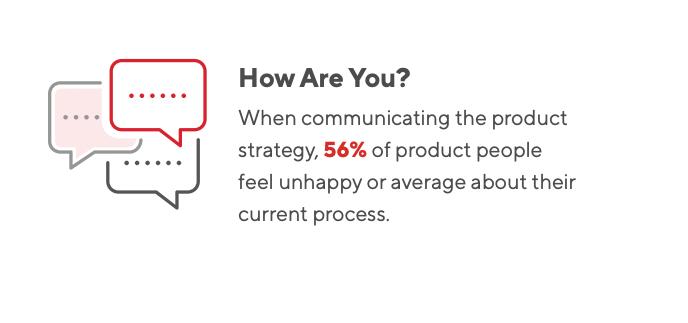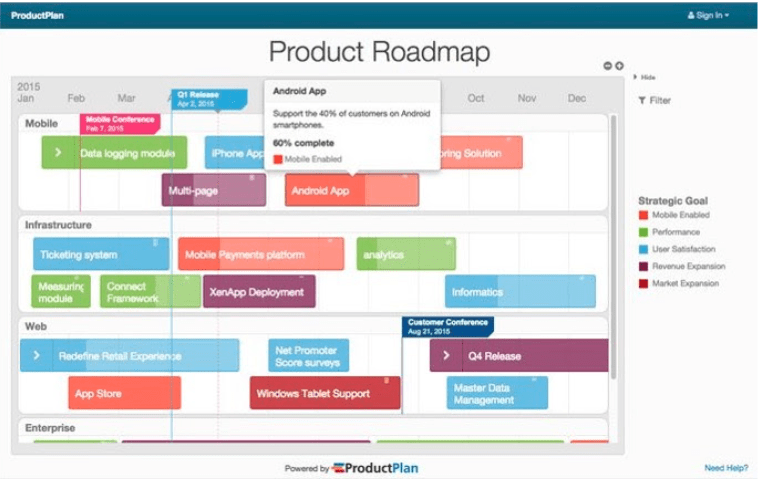Effective product team communication is not about talking to your team more often or providing them with more granular tasks. You want to make sure your team understands why what they’re doing matters.
As a product manager, you need to create an atmosphere that keeps the lines of communication open. Not just from you to your team, but from them to you, and to each other. You also want to communicate not only your tactical requirements but the strategy and vision for the product.
Why Poor Product Team Communication Can Kill Your Product
Industry surveys reveal that product managers view communication skills as the most important.
In our most recent annual survey—The 2021 State of Product Management Report—we found that product professionals rate communication #2 on the list of skills they believe their coworkers lack most.

And don’t assume this means product managers let themselves off the hook when it comes to their communication abilities. More than half of our 2021 survey respondents admitted they have room to improve. The improvement came in their process of articulating strategy to their product team.

What is this data telling us? Product professionals understand that clear, effective, and frequent communication among their team can affect whether a product succeeds or fails in the market.
But what does that mean? Simply stating the abstract phrase, “We need to improve product team communication,” doesn’t illustrate the problem clearly. So, let’s talk specifics.
When your product team is not communicating effectively that miscommunication can derail your product.
1. Your development team might take away the wrong success criteria.
You can generate what feels like consensus in a meeting with your cross-functional team. Everyone on the team might nod their heads as you say: “We want to create an intuitive, streamlined experience that solves the XYZ problem for our user persona. In actuality, everyone might have a different understanding of what to prioritize first. Moreover, this may affect how your team builds out the functionality.
2. Your marketing team might develop the wrong messages for your user persona.
Your marketing team might hear your goal to solve the XYZ problem, but do they know why it’s a problem worth solving? Do they know your target user or buyer—what that person needs, wants, fears?
You want your marketing coworkers to understand your product and customer so well that they feel enthusiastic as they develop your product’s marketing messages and campaigns.
That can’t happen if you don’t regularly communicate with your marketing team, show them the market data you’ve compiled, encourage them to sit in on your developers’ demos, etc.
Without that deeper understanding, your marketing team will parrot the terms and phrases you’ve given them. That’s no way to unlock their expertise and develop the most compelling messages possible.
3. Your sales team might focus on benefits that don’t resonate with prospects.
You can hand your sales department a bunch of collateral when the product is ready for launch: demo videos, slideshows, sales sheets, prospect emails.
But will that be enough to turn your reps into an army of enthusiastic, knowledgeable advocates for the product? Almost certainly not.
If you want your sales team to have a deep understanding of the product they’re offering—and the customer they’re offering it to—you need to give them enough of a sense of your product’s value that they become evangelists for it.
4. You might not hear that your development team isn’t equipped to realize your vision.
Remember, product team communication needs to go in every direction. That means you need to be listening to your coworkers and hearing what they’re telling you.
If you’re not willing or able to do this, you could build your entire plan around a development team trying to let you know they don’t have the resources, skillset, budget, or understanding to deliver what you want.
The team might not want to disappoint you, so they offer noncommittal responses to your feature requests and timeline. And if you’re not truly listening, you might miss those signals.
For these reasons—and a thousand more like them—you need to prioritize clear and open communication among your product team. Now let me give you a few tips for incorporating this strategy into your process.
5 Ways a Great Product Manager Creates Effective Product Team Communication
1. Answering questions around priorities.
As you begin to translate your high-level product vision into a strategic action plan, you can expect to hear questions, concerns, and challenges from your cross-functional team. Your action plan will require work from them, of course, and they might have questions about what should come first.
A great product manager is ready for these challenges with evidence, strategic reasoning, and, above all, patience.
Every question you hear from your cross-functional team consists of two parts—the spoken question and the unspoken “why” behind it.
Pro tip: Start your answer by providing the why behind the question and see if your team can get to your answer before you reveal it to them.
2. Explaining the product story.
Well-told stories are memorable and influential. That’s why we still remember fairy tales and parables we heard in childhood.
A great product manager can turn the details of a product concept into a story that’s clear, engaging, and fun to hear. A compelling product story can make it easier for your team to communicate the product’s value to each other—because they remember the story.
Imagine: You’re trying to develop a financial app to let parents give teenagers an allowance and monitor their spending habits. Rather than start by telling your cross-functional team all about the product’s features or what types of coding the app will need, you can give everyone a brief story:
“Charlie’s parents are done handing him cash every week, asking him a few days later what he’s done with the money and hearing, ‘I forgot.’” Our app is going to put Charlie’s spending on the grid. We’re going to relieve mom and dad of the head-bashing frustration of trying to decide every week whether to send Charlie’s allowance into a black hole. We’re going to help these well-meaning parents give their son some independence… with limits.”
Everyone on the team can now keep this memorable story as a reference while working on the product. If the product team gets stuck or confused, the team can ask themselves, “Is this going to help us help parents give their teenage kids independence and financial limits?”
3. Listening to the team.
Great product managers don’t just talk. They listen.
As I noted above, listening means paying attention not only to what your team is saying but the implications behind it.
If your developers ask why you have prioritized an initiative, they ask because they don’t understand its strategic value? Or is it because they don’t think they can complete the project but are uncomfortable saying so? Is there a different reason altogether?
When you receive questions or challenges from members of your team, you should not assume you’ve effectively resolved the issue just because you’ve answered. You also need to make sure your coworkers understand your reasoning and agree to whatever you’re asking of them.
Every person on your cross-functional team comes to their work from a unique perspective, with a fantastic set of skills and hopes, and challenges. They all have something valuable to contribute to your product’s success—even if it’s something you’d rather not hear, such as a warning about resource levels or your timeline. The only way to give your product the best chance of success is to listen to your team’s unique insights.
4. Staying available and accessible.
Fortunately, we’re in the digital and mobile era. Staying accessible to your product team is easier than it’s ever been. You can set up Slack channels or an MS Teams environment to chat with your team anytime.
Great product managers make themselves approachable to their cross-functional team, and they respond to questions and requests with enthusiasm and a positive attitude.
You don’t need a 24-hour policy where you promise to answer any text within 15 minutes. But you do want to send your coworkers the signal that you welcome their feedback and questions throughout the product development process.
5. Sharing a clear, up-to-date roadmap.
Finally, a great product manager builds and shares a roadmap that answers the team’s strategic questions.
For a product manager, this means including, wherever possible, your strategic reasoning alongside every theme and epic you add to your roadmap. Suppose your sales team popped open your roadmap and saw that your next priority was to develop an Android version of your app. Could they also know the evidence for why you chose that as the product’s following significant enhancement?

As you can see from the above ProductPlan screenshot, you can quickly drop in a note about why you’ve decided to work on each item on the roadmap with our app.
This is another reason to use a purpose-built roadmap app instead of building out your product roadmap in a spreadsheet. All the extraordinary product managers are doing it these days.

Building a Team of Effective Product Managers (and a Path to Product Leadership)
I hope you’ve found my reasoning for effective product team communication persuasive and that my suggestions can help you get there. But I want to leave you with one more thought.
As a product leader for years and a product manager for years before that, I can tell you from firsthand experience that building a solid communication foundation for your team can also create direct benefits for your career.
First—and this is true primarily with larger companies—you’ll be building a model for the other product managers in your organization to follow. And there’s a good chance your company’s executive staff will notice what you’re creating as well. They’ll want the great chemistry, the positive team conversations, the good outcomes that they see happening with your cross-functional product team.
A second related benefit: When you’ve demonstrated that you can build a streamlined product team where everyone is speaking the same language, you’ll be adding a solid skill to your arsenal, one that often leads to product leadership.





